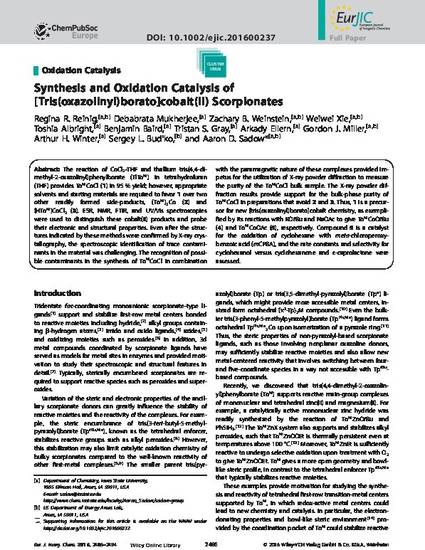
The reaction of CoCl2·THF and thallium tris(4,4-dimethyl-2-oxazolinyl)phenylborate (TlToM) in tetrahydrofuran (THF) provides ToMCoCl (1) in 95 % yield; however, appropriate solvents and starting materials are required to favor 1 over two other readily formed side-products, (ToM)2Co (2) and {HToM}CoCl2 (3). ESR, NMR, FTIR, and UV/Vis spectroscopies were used to distinguish these cobalt(II) products and probe their electronic and structural properties. Even after the structures indicated by these methods were confirmed by X-ray crystallography, the spectroscopic identification of trace contaminants in the material was challenging. The recognition of possible contaminants in the synthesis of ToMCoCl in combination with the paramagnetic nature of these complexes provided impetus for the utilization of X-ray powder diffraction to measure the purity of the ToMCoCl bulk sample. The X-ray powder diffraction results provide support for the bulk-phase purity of ToMCoCl in preparations that avoid 2 and 3. Thus, 1 is a precursor for new [tris(oxazolinyl)borato]cobalt chemistry, as exemplified by its reactions with KOtBu and NaOAc to give ToMCoOtBu (4) and ToMCoOAc (5), respectively. Compound 5 is a catalyst for the oxidation of cyclohexane with meta-chloroperoxybenzoic acid (mCPBA), and the rate constants and selectivity for cyclohexanol versus cyclohexanone and ε-caprolactone were assessed.
Available at: http://works.bepress.com/aaron_sadow/51/

This is the peer reviewed version of the following article: Reinig, Regina R., Debabrata Mukherjee, Zachary B. Weinstein, Weiwei Xie, Toshia Albright, Benjamin Baird, Tristan S. Gray et al. "Synthesis and Oxidation Catalysis of [Tris (oxazolinyl) borato] cobalt (II) Scorpionates." European Journal of Inorganic Chemistry 2016, no. 15-16 (2016): 2486-2494, which has been published in final form at DOI:10.1002/ejic.201600237. This article may be used for non-commercial purposes in accordance with Wiley Terms and Conditions for Self-Archiving.